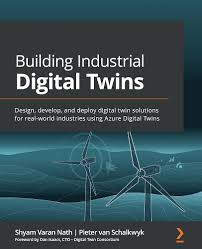Building Industrial Digital Twins: A Comprehensive Guide
This white paper explores the key concepts, technologies, and applications presented in "Building Industrial Digital Twins: Design, develop, and deploy digital twin solutions for real-world industries using Azure Digital1 Twins" by Packt Publishing. It provides a comprehensive overview of industrial digital twins, their significance in modern manufacturing and industry, and their potential to revolutionize operational efficiency and decision-making.
1. Introduction
An industrial digital twin is a virtual representation of a physical asset, process, or system. It leverages data from sensors, simulations, and other sources to create a dynamic and interactive model that mirrors the real-world entity. This virtual replica enables organizations to gain valuable insights into the performance, behavior, and health of their assets, optimize operations, and improve decision-making.
2. Key Concepts and Components
- Data Acquisition: Gathering real-time data from sensors, IoT devices, and other sources.
- Data Processing and Analysis: Processing and analyzing data using techniques such as data streaming, machine learning, and artificial intelligence.
- Digital Twin Model: Creating a virtual representation of the physical asset or system, incorporating its characteristics, behavior, and interactions.
- Simulation and Modeling: Simulating different scenarios and predicting future outcomes based on real-time data and historical trends.
- Visualization and Human-Computer Interaction: Providing intuitive interfaces for users to interact with the digital twin, visualize data, and gain insights.
3. Benefits of Industrial Digital Twins
- Improved Operational Efficiency: Optimize production processes, reduce downtime, and improve asset utilization.
- Predictive Maintenance: Predict equipment failures before they occur, minimizing downtime and maintenance costs.
- Enhanced Product Design and Development: Optimize product design, improve performance, and accelerate time-to-market.
- Risk Mitigation: Identify and mitigate potential risks and hazards, improving safety and reducing operational disruptions.
- Data-Driven Decision Making: Gain valuable insights from data to make informed business decisions and optimize operations.
4. Use Cases of Industrial Digital Twins
- Manufacturing: Predictive maintenance, process optimization, quality control, and supply chain management.
- Energy: Predictive maintenance of wind turbines, optimizing power grid operations, and improving energy efficiency.
- Transportation: Optimizing traffic flow, improving vehicle performance, and enhancing passenger safety.
- Healthcare: Personalized medicine, remote patient monitoring, and improving the efficiency of healthcare delivery.
- Smart Cities: Optimizing urban infrastructure, improving resource management, and enhancing citizen services.
5. Technologies and Platforms
- IoT Platforms: Azure IoT Hub, AWS IoT, Google Cloud IoT Core.
- Cloud Computing Platforms: Azure, AWS, Google Cloud Platform.
- Data Analytics Platforms: Microsoft Azure Synapse Analytics, AWS Glue, Google Cloud Dataflow.
- Simulation and Modeling Tools: MATLAB, Simulink, ANSYS.
- Artificial Intelligence and Machine Learning: Machine learning frameworks (TensorFlow, PyTorch), AI/ML services (Azure Machine Learning, AWS SageMaker, Google Cloud AI Platform).
6. Building an Industrial Digital Twin
- Define Objectives and Scope: Clearly define the business goals and scope of the digital twin project.
- Data Acquisition and Integration: Gather data from various sources and integrate it into a central data repository.
- Model Development: Create a virtual representation of the physical asset or system using appropriate modeling techniques.
- Simulation and Analysis: Conduct simulations, analyze data, and generate insights.
- Visualization and User Interface: Develop user-friendly interfaces for interacting with the digital twin and visualizing data.
- Deployment and Maintenance: Deploy the digital twin solution and continuously monitor, maintain, and update it based on new data and evolving requirements.
7. Challenges and Considerations
- Data Quality and Integrity: Ensuring the accuracy and reliability of data is crucial for the success of a digital twin.
- Data Security and Privacy: Protecting sensitive data and ensuring compliance with relevant regulations.
- Scalability and Performance: Building scalable and high-performance digital twins to handle large volumes of data and complex simulations.
- Integration and Interoperability: Integrating digital twins with existing enterprise systems and applications.
- Skills and Expertise: Developing and maintaining digital twins requires a skilled workforce with expertise in data science, engineering, and IT.
8. References
- "Building Industrial Digital Twins: Design, develop, and deploy digital twin solutions for real-world industries2 using Azure Digital Twins" by Shyam Varan Nath, Pieter van Schalkwyk, Dan Isaacs (Packt Publishing)
- "Digital Twin Technology: Principles and Applications" by Michael Grieves (Springer)
- "Industry 4.0: Building the Future of Manufacturing" by Henning Kagermann, et al. (Springer)
- Azure Digital Twins Documentation: https://docs.microsoft.com/en-us/azure/digital-twins/3
- AWS IoT: https://aws.amazon.com/iot/
- Google Cloud IoT: https://cloud.google.com/iot/
- Gartner: https://www.gartner.com/ (for industry research and analysis)
9. Conclusion
Industrial digital twins are emerging as a critical technology for driving innovation and improving operational efficiency across various industries. By leveraging data, simulation, and advanced technologies, organizations can unlock new levels of insights and optimize their operations in unprecedented ways.
Disclaimer: This white paper provides a general overview of industrial digital twins and their applications. The specific requirements and implementations will vary depending on the individual use case and industry.
This information is for general knowledge and informational purposes only.



